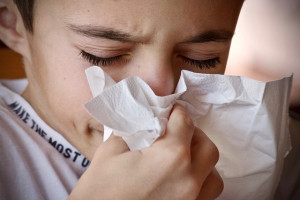Viruses are very tiny germs that consist of genetic material (DNA or RNA) inside a protein coating. Unlike bacteria, viruses cannot survive on their own. They need host cells [MedlinePlus 2016].

Harmful free radicals play an important role in viral infections. The cells’ normal metabolism of oxygen generates reactive oxygen species as a by-product. At low and stable levels, these “free radicals” play a role in cell signaling and cell functioning. In the course of viral infections, however, the over-production of free radicals can overwhelm the body’s protective antioxidant systems and can cause oxidative stress [Guillen 2019].
Oxidative stress is defined as an imbalance between the generation of harmful free radicals and the availability of protective antioxidants.
Antioxidants are needed to prevent oxidative damage to cells and to proteins, lipids, and DNA in the cells.
Oxidative stress has been implicated in many illnesses caused by viral infections. Moreover, unchecked, the harmful free radicals can enhance the replication of the invasive viruses [Guillen 2019]. This is the biological equivalent of a double whammy: increased oxidative stress and stimulation of the replication of the virus itself.
Selenium Status Important in Viral Infections
Viral infections are especially dangerous because they both increase the need for micronutrients such as selenium and cause the loss of micronutrients [Guillen 2019] . The resulting deficiency of selenium, for example, must be compensated for by means of oral selenium supplementation.
The human body does not synthesize selenium to meet its needs for this trace element. Furthermore, in many regions of the world, the content of selenium in the soil and in the food is low [Stoffaneller & Morse 2015; Winther 2020, figure 2].
Role of Selenium in Antioxidant Defense
Through the activity of several of its selenoproteins, selenium plays an important role in antioxidant defense. Some selenoprotein families, in particular the glutathione peroxidases and the thioredoxin reductases, are important for controlling oxidative stress.
In addition, selenium deficiency is associated with an increased capability of viruses to cause diseases. This increased pathogenicity of viruses occurs for two reasons [Guillen 2019]:
- There is less selenoprotein expression to combat the oxidative stress.
- In conditions of low selenium status and increased oxidative stress, some viruses mutate from mildly pathogenic strains to highly virulent strains.
Selenium Deficiency and SARS-Cov-2 Virus
Selenium deficiency changes both the immune response to viral infections and the nature of the viral infection itself. Low selenium status contributes to increases in oxidative stress and to increases in the rate of mutations in the viral genome. The result is increased viral capacity to cause infection and damage to the host cells.
For example, the available research literature examining SARS-CoV-2 virus infections and selenium status shows a link between selenium status and the severity of COVID-19 outcomes [Martinez 2022].
Conclusion: Selenium Status and Viruses and Viral Infections
Selenium status needs to be monitored in patients at risk of viral infections. Low selenium status has been associated with more severe infection outcomes and with the mutation of viruses to more virulent forms. In future, circulating Selenoprotein P concentrations may become the go-to biomarker of selenium supply, at least up to the point where Selenoprotein P concentrations reach a plateau and a saturated selenium status has been achieved [Schomburg 2022].
In the meantime, here are general health guidelines for serum/plasma selenium status [Winther 2020, figure 3]:
- Deficient: below 70 mcg/L
- Insufficient: between 70 and 85 mcg/L
- Optimal: around 125 mcg/L
A comparative test of two different forms of selenium on oxidative stress biomarkers in healthy men has shown that supplementation with selenium yeast but not with pure selenomethionine is associated with a decrease in oxidative stress. This suggests that selenium species other than selenomethionine in the selenium yeast preparation account for the decrease in oxidative stress [Richie 2014].
Sources
Guillin OM, Vindry C, Ohlmann T, Chavatte L. Selenium, selenoproteins and viral infection. Nutrients. 2019 Sep 4;11(9):2101.
Martinez SS, Huang Y, Acuna L, Laverde E, Trujillo D, Barbieri MA, Tamargo J, Campa A, Baum MK. Role of Selenium in Viral Infections with a Major Focus on SARS-CoV-2. Int J Mol Sci. 2021 Dec 28;23(1):280.
MedlinePlus [Internet]. Bethesda, MD: National Library of Medicine; [updated 2016 Aug 31]. Viral infections. Available from: https://medlineplus.gov/viralinfections.html.
Richie JP Jr, Das A, Calcagnotto AM, Sinha R, Neidig W, Liao J, Lengerich EJ, Berg A, Hartman TJ, Ciccarella A, Baker A, Kaag MG, Goodin S, DiPaola RS, El-Bayoumy K. Comparative effects of two different forms of selenium on oxidative stress biomarkers in healthy men: a randomized clinical trial. Cancer Prev Res (Phila). 2014 Aug;7(8):796-804.
Schomburg L. Selenoprotein P – Selenium transport protein, enzyme and biomarker of selenium status. Free Radic Biol Med. 2022 Oct;191:150-163.
Stoffaneller R, Morse NL. A review of dietary selenium intake and selenium status in Europe and the Middle East. Nutrients. 2015 Feb 27;7(3):1494-537.
Winther KH, Rayman MP, Bonnema SJ, Hegedüs L. Selenium in thyroid disorders – essential knowledge for clinicians. Nat Rev Endocrinol. 2020 Mar;16(3):165-176.
The information presented in this review article is not intended as medical advice and should not be used as such.
15 November 2022
